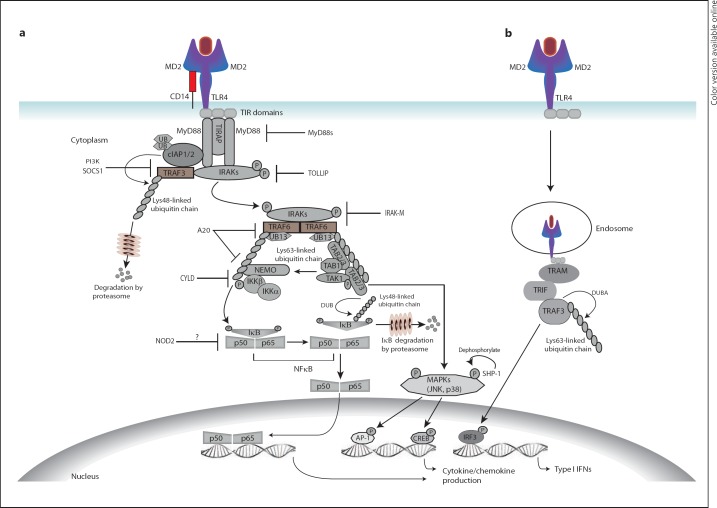Fig. 3.
Termination of innate immune signalling by intracellular regulators. a In MyD88-dependent TLR signalling, Lys63 ubiquitination of TRAF6 causes its oligomerisation and triggers its E3 ligase activity. TRAF6 then synthesises poly-ubiquitin chains that bind the NEMO subunit of the IKK complex and the TGF-activating kinase (TAK)-binding protein (TAB2 and TAB3) subunits of the TAK1 complex with subsequent activation of kinases. Phosphorylated IκB (inhibitor of NFκB) is Lys48-linked poly-ubiquitinated and undergoes proteosomal degradation, releasing the NFκB dimer p50/p65 into the nucleus to switch on target genes including IKK inhibitor A20. Phosphorylated TAK1 may also induce target genes via downstream MAPK pathways. NFκB signalling is selectively terminated by A20- and probably CYLD-mediated Lys63 de-ubiquitination of TRAF6 and IKK leading to inhibition of IKK. Moreover, IκB is rapidly de novo synthesised and its Lys48 de-ubiquitination prevents its proteosomal degradation. b In MyD88-independent TLR signalling, de-ubiquitination of TRAF3 by DUBA is a specific and critical negative regulator of type 1 IFN production. Moreover, TLR signalling is auto-inhibited by several molecules that are induced by activation of TLRs. These include MyD88s, which competitively blocks association of IRAK4 with MyD88, IL-1R-associated kinase M (IRAK-M), which inhibits dissociation of IRAK1-IRAK4 complexes from the receptor, and other inhibitory proteins such as TOLLIP, SOCS1, PI3K, NOD2 and SHP-1. TIRAP = TIR domain-containing adaptor protein; cIAP = cellular inhibitor of apoptosis; TRIF = TIR-domain-containing adapter-inducing IFN-β; TRAM = TRIF-related adaptor molecule; IRF3 = IFN-regulatory factor 3; AP-1 = activator protein-1; CREB = cyclic AMP-responsive element-binding protein.

